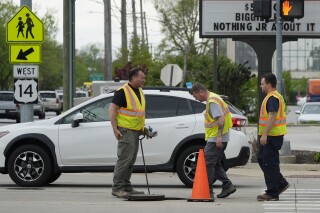How the AP counts the vote and declares winners in US elections

Instead of relying on crowd-sourcing or vulnerable technology, our 50-state network of local reporters have first-hand knowledge of their territories and trusted relationships with county clerks and other local officials. These stringers collect votes at a local level.
We also gather results from state or county websites and electronic data feeds from states.
On election night, race callers in each state are armed with a wealth of additional detailed information from our election research team, including demographics, the number of absentee ballots, and political issues that may affect the outcome of races they must call.
Race callers are part of AP’s Decision Team, which declared winners in more than 7,000 races in the 2020 general election.
The process
1. Collect the votes
Our vote count reporters collect votes at a local level from county clerks throughout the night. They also monitor government web sites where vote totals are posted by election officials.
2. Enter the results
The vote count reporters call in results to a vote entry clerk, who keys in the results to AP’s election system. Those clerks also enter results from official sources online and monitor automated feeds provided by election officials.
3. Double check, and check again
Vote results are subject to intense verification efforts, so that AP’s race calls are unfailingly accurate. In 2020, we were 99.9% accurate in calling U.S. races and 100% accurate in calling the presidential and congressional races in each state.
4. Deliver the results – fast
Results are sent to AP customers, who report them on air and online. Results are updated throughout the evening and the days following Election Day, until every race is called and state officials certify their results as final.
What is involved on Election Day?
From before dawn and continuing until the count is complete weeks after Election Day, thousands of AP journalists work around the clock to report on the results of a U.S. general election. Political reporters spend their day with candidates and interviewing voters. Vote count reporters and vote entry clerks work together to collect results at thousands of county election offices and voting precincts from coast to coast, and AP’s Decision Team then uses those results to declare winners up and down the ballot. Software engineers and technical staff monitor our systems and keep the results moving smoothly to our members and customers around the globe.
It’s all part of a tightly calibrated plan designed to accurately and swiftly report the nation’s election results – the largest single act of journalism there is.
How does AP gather the votes?
Before polls close, over 4,000 vote count reporters arrive at county election offices and local voting precincts. When the first polls close, they’ll be ready to report on the results from inside the locations where ballots are actually counted, phoning in raw vote totals as soon as they are available. In all, there’s an AP vote count reporter at nearly every county election office in America on Election Day.
Close to 1,000 vote entry clerks will answer calls from vote count reporters and walk each through a precise process designed to quickly and accurately enter each candidate’s vote totals into our election night reporting system. The clerks are encouraged to ask questions of the reporters to ensure the count is correct. They’ll ask whether there are any problems in their county, and question the reported vote totals if the results look unusual. Built into the election night reporting system are a series of automated quality control checks that interrupt clerks if something submitted appears amiss, requiring confirmation of numbers if they are inconsistent or statistically unlikely.
Since many states and counties display election results on websites, another group of clerks monitors those sites and enters the results into the same system. AP also takes in feeds of results directly from election officials where they are provided, and uses automated tools to “scrape” results from official government websites. Our goal is to have at least two, and in many cases three or more, sources for vote totals from every county. Those multiple sources don’t just serve as a backup to each other, but they also provide a check to help ensure the vote totals we are reporting are correct.
How else does AP make sure the count is accurate?
At every step in the process, we’ve built in checks and double checks that are applied by the human vote count reporters and vote entry clerks. And then, the vote totals they enter into our election night reporting system are checked again by dozens of automated tests that look at the numbers from every possible angle in search of discrepancies or apparent inconsistencies.
For example, if a clerk tries to enter a vote total for a candidate that is greater than the number of registered voters in a county, the system will force them to stop and double check their work. Any time a clerk enters totals that show a significant disparity from expected patterns or a county’s previous voting history, they’ll be asked to slow down and confirm with a supervisor the numbers they have are correct.
Separately, our full-time team of election research and quality control analysts are monitoring the results as they are entered and looking for anomalies, using sophisticated tools and our own research to ensure what AP reports is the true and accurate count of votes. They’re alerted every time a new candidate takes the lead in a race, for example, and they then check to make sure that lead change is legitimate.
What about technical problems?
We take the role AP plays in the American democracy seriously, and that applies to the tools we use to count the vote as much as it does to the processes we use to tabulate the vote.
Every part of our election night reporting system has a fully redundant backup that will allow us to keep counting the vote in the case of a technical failure. If one or more of AP’s systems goes down, the system automatically fails over to a backup system. These systems undergo extensive testing.
How does AP report the expected vote?
Among the questions most often asked after polls close is, “How many votes are left to count?” We do our best to answer that question by reporting an estimate of the percentage of vote counted alongside the actual vote totals.
We start by estimating the overall expected turnout in a state based on a variety of factors, such as turnout in recent elections and details on early voting. This is done as a comparison to the turnout in a past election; for example, we might estimate the total number of ballots cast in a state in the 2022 general election vote will be 103% of the number of votes cast in that state in the 2018 general election.
As more states expand early voting and voting by mail, the details on advance vote become more important and valuable in setting that initial estimate. It provides us with a known data point for the current election, helping make the estimate more precise from the outset. In some states, election officials will also tell us how many people voted in person on Election Day. Once polls close and we start getting actual returns, we further refine the estimate with actual data.
To be sure, our reporting of expected vote is an estimate. It can and will fluctuate as the vote tabulation takes place and we learn more about how many people have actually cast a ballot.
What about “precincts reporting”?
In some states, the percentage of precincts reporting is a reasonably accurate estimate of the amount of vote that’s been counted – particularly in those states that do not separately report results for ballots cast in advance from those cast on Election Day. We use precincts reporting as one of the data points that helps us estimate the amount of vote left to be counted.
In other states, however, the percentage of precincts reporting can be deceiving.
In some jurisdictions, election officials may report all of the votes cast early as being from a single precinct. A precinct may also initially release some – but not all – of its results, which means there can still be votes left to count in a precinct counted as reporting. This is why it’s possible for more votes to be added to the count in a race even when 99% or more of precincts are reporting. This issue is often evident in a race where mail ballots may be accepted and counted well after Election Day. This is not a new phenomenon, but it has become more of a challenge due to the expansion of advance voting spurred by the start of the coronavirus pandemic in 2020.
In all races tabulated by AP, we do provide details on precincts reporting. But we think our expected vote estimate more consistently provides the best available picture of how many votes are left to be counted, which is why that’s the figure we use on our election maps and in our news report to describe the state of every race.
When does AP start publishing results?
AP begins reporting election results as soon as they are available on the day of an election, which may be as early as the first statutory poll close time in a state.
Poll close times vary from state to state, and some states have multiple poll close times depending on how many time zones fall within its borders.
It’s tradition for some small towns in New Hampshire, such as Dixville Notch and Millsfield, to open their polls at 12 a.m. ET on Election Day and report their results as soon as voters have finished casting their ballots – long before New Hampshire releases statewide results.
We report the vote from Dixville Notch and Millsfield as soon as it becomes available … and then wait with everyone else for polls to start closing nationwide come election night.
How does redistricting affect the vote count?
Every 10 years, and occasionally more often due to legal challenges, the boundaries of districts in the U.S. House of Representatives and state legislatures nationwide are redrawn to reflect the results of the latest U.S. Census. Our reporting of the vote totals, and our presentation of vote tallies on election results maps and other charts, reflects those updated districts.
In some states, the changes to district lines are small. In others, entirely new maps are required to account for the addition of a seat to account for a growing population. That means in other states, a new map is needed to account for the subtraction of a district. This can lead to confusion as incumbent office holders adjust to the boundaries of new legislative districts.
Here’s how we handle it at AP.
An incumbent is a current holder of an elected office. During an election, a candidate is labeled as an incumbent if they are seeking reelection to their current legislative body or public office. For example, a current member of the U.S. House seeking any seat in the U.S. House will be labeled an incumbent. But a current member of the House seeking election to the U.S. Senate will NOT be labeled as an incumbent.
Incumbents may seek reelection in a district with different boundaries and district names than in the preceding election, prior to the redistricting process. For example, a U.S. House member currently representing a state’s 1st Congressional District seeking reelection to the U.S. House in the state’s newly created 2nd Congressional District is still an incumbent. This means that it is possible for a race to feature two or more incumbents.
Why might election results fluctuate on election night?
Elections in the United States can be messy affairs. Voters cast ballots in dozens of different ways in more than 10,000 jurisdictions across the country, and elections officials release results in hundreds of different ways. Voters are human – and so are the people who collect and count their ballots. They make mistakes on occasion. Those mistakes are almost always caught within a few minutes. Sometimes within a few seconds. It’s rare that an error lingers for hours.
AP employs dozens of quality checks on the results it collects and tabulates, and quite often, we’re able to spot errors and inform local election officials about an unusual number before it’s published. But on occasion, an honest mistake does make it past elections officials and AP alike. It’s our job, and our commitment, to fix those errors as soon as they are discovered.










